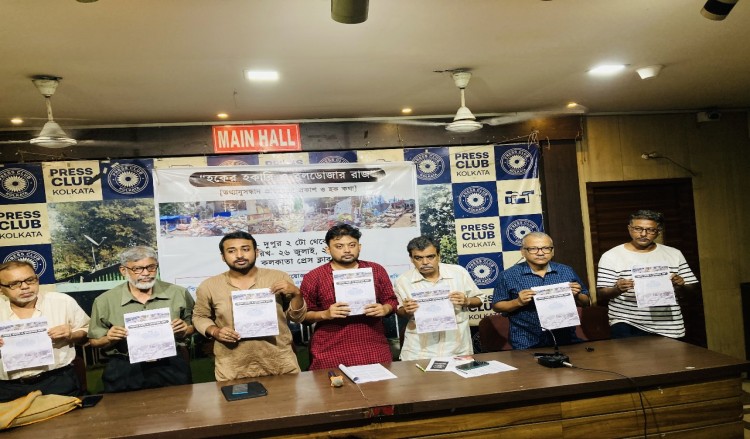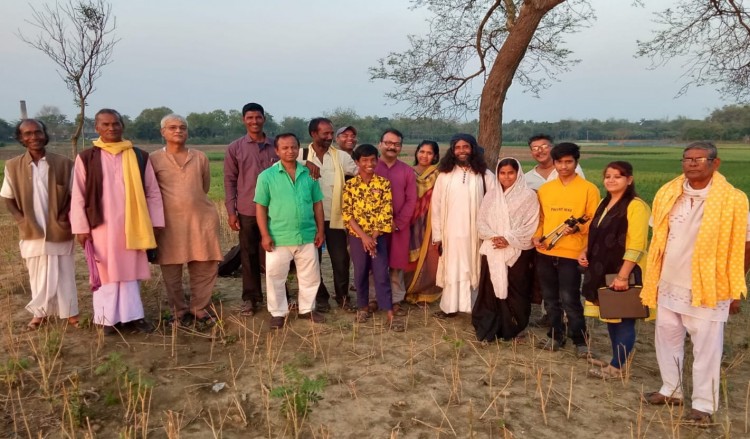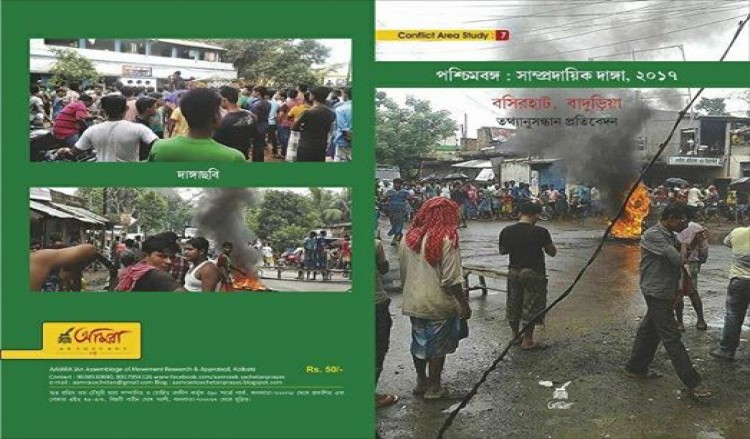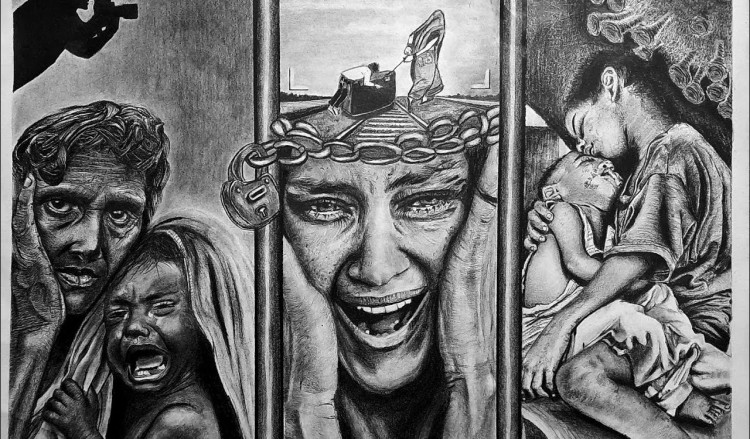
Bhandardaha : Imperatives, Conflicts and Interests
Bandardaha Bil is belongs to their people and adjacent creatures. This Bil is the cause of their life. They can’t separate it with so many co-operatives. It is impossible to distribute the fish and other water resources equally according to man-created margins. In the name of competition there is politicization and increased role of the middlemen, where ordinary fishermen have no role to play.
Bhandardaha : Imperatives, Conflicts and Interests
Subha Protim Roy Chowdhury
An Assemblage of Movement Research & Appraisal (AAMIRA)
393, Survey Park, Kolkata - 700 075
Bhandardaha : Imperatives, Conflicts and Interests
First Published : 2012
Second Edition : 2016
Fact-Finding
Suresh Bhdra
Anupam Das Adhikary
Subha Protim Roy Chowdhury
In Association with
Shromojibi Samiti and Khet Majur Sangha
Report Presented in
INSTITUTE OF DEVELOPMENT STUDIES OF KOLKATA
An Assemblage of Movement Research & Appraisal (AAMRA)
393, Survey Park, Kolkata - 700 075
E-mail: aamrasachetan@gmail.com, Blog : Aamracksachetanprayas
www.facebook.com/aamraek.sachetanprayas
Tel: 9038530690, 8017954126
DTP & Cover Design
Suman Bhadra
Published by: Anupam Das Adhikary on behalf of
‘AAMRA’ Ek Sachetan Prayas
Printed at:
PRATYAYA
24/1B, Creek Row, Kolkata - 700 014
“This is our Bil
Our Bil belongs to our people,
Belongs to all kingfisher, heron and millions of migratory birds
Belongs to all fish, toad and earthworm
There is no need to pove this
With a legal entity of the Bil-
We deserve to call it our ‘Mother’
to occupy its everything
to face its flood, sediment, sub-aquatic life
This is our water
Unchallengingly our”
[Extract from a poem of Basudeb Halder, an activist of Bhandardaha movement, resident of Cassipore village, Murshidabad, West Bengal.]
The extensive family of the Gangetic rivers (like the Ganga, the Yamuna), their tributaries, river-branchs; one of the largest alluvial plains in tropical region had already achieved substantial concentration by the national and international field-researchers. Though the environmental study of small rivers has not yet gained such needful recognition and support. The riverine community, their dependency on river-resources, geomorphic challenges they faced and the geo-political obstacles jeopardize their livelihood, all are often neglected by the researchers, academicians. The river draining the Eastern Gangetic Plains (EGP) have higher sediment yield due to lower stream power, that impact in aggradations.
Bhandardaha, branch of the Padma as opined by the river-expert Mr. Kalyan Rudra, contradicts local folk who call it as ‘Bil or Swamp. On behalf of “Aamra- ek sachetan prayas” (a Socio-Economic field study group of Kolkata), an wing of AAMRA (An Assemblage of Movement Research and Appraisal), we envisaged the region on 8 December, 2007 for the first time. That ephemeral tour followed by series of socio-economic field study on consecutive years up to 2010. Near 70,000 populace faced environmental degradation, conflict and forced migration in this part of Murshidabad District.
In this paper, I would like to expostulate the actuality I experienced with the Bhandardaha people in a vivid vocabulary. This paper may focus on how environmental change and disparities of administrative ranks persuade the decade-long conversion between capabilities and vulnerabilities.
Bhandardaha Swamp and the beginning of a change
Murshidabad is divided by the Bhagirathi River into two geo-historical regions, western side is Rarb and eastern side is Bakri. Bhandardaha Swamp comprises of 4 blocks of Bakri - Murshidabad. This water-body which is 85 kms in length is probably the largest in West Bengal. The source of this water-body is from Akhirgunj by the Padma River. The waters later flow through Bhagwangola Lalbagh, then through Bali Khal (Canal) and Bandardaha khal, further flowing through Dara (Flow of water) of Shalmara Kodalkati and then finally crashing into the water of the River Jalangi. The four blocks that this swamp covers are Beldanga, Berhampur, Hariharpara and Naoda. On the northern part of the Swamp is Hariharpara and Naoda block and towards the south is Berhampore and Beldanga-1. The swamp covers a wide area from north to south. In the villages on either side of the swamp reside almost 70,000 fishermen and farmers whose lives and livelihood are linked to this swamp. In this area, the markets, selling agricultural products, the haat (weekly rural markets), the Arot (Godown), the fish-markets and other related businesses are directly or indirectly linked to Bhandardaha. The financial matters of the twenty seven villages belonging to the four blocks are revolving around the Bhandardaha Swamp. The villages are —
Beldanga
1. Kalitola 2. Fatehnagar
3. Anandanagar 4. Maniknagar
5. Pohopar 6. Dayanagar
7. Pilkhana 8. Zafarabad
9. Radhanagar 10. Kheyali
11. Jorgacha 12. Bet Beriya
13. Ratanpur 14. Shahapur
Berhampore
1. Simulia 2. Daulatpur
3. Sreerampore 4. Mahishmara
5. Katabagan
Hariharpara
1. Tekpara 2. Daulatpur
3. Bhandardaha 4. Mahishmara
Naoda
1. Ghoramara 2. Kedarchandpur
3. Chandpur 4. Bagartapara
Owing to geographical factors, there are steep slopes on either sides of the swamp and this is known as khari or inlet. From the inlet, tiny streams emerge, known as dara (flow of water) and pass through the villages. From the beginning till the end of the Bhandardaha Swamp, there are eight inlets. The names of the inlets are Lalbagh topkhana, Khagrabormuri, Dakuri, Baushkhali, Pechaidala, Pohobil, Durman, Gangar Khari. There are countless daras. Most of the time there is water in the inlet but it may not be so in the daras. Let us take for example the Shalmara dara wherein there is no water for 6 months from the month of January till June-July. For this reason navigability and irrigation largely disrupts.
Bhandardaha is the den of the fish varieties. Once Bhandardaha was called as Ratnakaror the mine of Jems. Every day local people used to be a catch of khoira fish of almost 20 to 24 quintal. Shells used to be found, out of which buttons used to be made. Besides, fishes like shoal, boal (sheat-fish), puti, tangra and other fishes found their natural habitat in this pond. The tools as well as the style of catching fish are multi-varied. The tools used for catching fish depend on the depth of the water, the quantity of the fish as well as the size of the fishes. Tools are Baansjaal (bamboo-net), kocha l(It is a big net and takes 14 people to lay the net), kheyajal (ferry-net), tyogil together a lot of people throw the borshi or fishing-hook into the water, there is a phatna or buoy in every hook), ghuni or fish-catching cage. Here a lot of folk song, folk-play inspired by the varieties of fish, fishery and net were a popular amusement medium.
Other important habitats of this swamp are medium sized, short-tailed decapods, crabs. Their nearest neighbors, tortoise, the herbivorous once had a dense population. A daily transportation of 2 quintal of crab and tortoise on the year 1978 (in winter season) was reported. We received data from old records of an Arot (Godown) of Kalikapur. Prawn, shrimp, snail, watersnail all the varieties of deep and medium-deep water levels of Bhandardaha had a potential of diverse biodiversity. Here livelihood pattern presupposing ecology and economy as an indivisible continuum in the context of human interferences with nature.
Carapaces, shell of snail are used for the production of shell-lime. Villages like Mahishmara, Bagartapara had a traditional cottage-industry of lime. Persuasively those are not felt down, though the productivity faces an all-time decline due to low supply of raw-material.
Bhandardaha also contains a varied species of rotifers, the ‘Nature’s water purifiers’. About 2000 species of these microscopic, multi-cellular, aquatic invertebrates are spread throughout the world. Here in the slow-moving water area these incessant hunters perform an important cleanup service by eating algae, crustaceans and other big rotifers.
We know that, sediment is important because it often enriches the soil with nutrients. Areas rich in sediments are also often rich in bio-diversity. Sedimentary soil is usually better for farming. For thousands of years, the Gangetic rivers flooded yearly and brought with it million metric tons of nutrient-rich sediment. The banks of Bhandardaha, the above mentioned villages, where suspended sediments are deposited are rich in agro economics for the huge production of paddy, jute etc.
In our field-research the relationship among land use, erosion and sedimentation is not clear and probably beyond our capacity level. The only substantive progress we gathered, the historiography of mass-movement since 1956. This study contains some geo-economic and geo-political notions.
Mass Movement of 1956
During the zamindari (land lord) rule under British Raj in accordance with the arrangements of fish-catching process and tools taxes had to be paid.
The Roy family in Bhagirathpur was the zamindar of this water resource. It was the year of 1956, though zamindari or landlord system was abolished long ago but Bhandardaha belongs to a different world. Ijaradar (lease holder) Sudhanshu increased the taxation system of the zamindari era. The income of the fishermen reduced a lot as a result of the cost incurred for fishing equipments and increased taxation. The fisherman started to revolt. Torture was inflicted on the fishermen and there was immense pressure to pay high taxes. Land lords recruited Lethel (club-men). The nets were taken away and their homes pulled down. Laying the Kochal net was prohibited and it was burnt. And the people revolt against this. They refused to budge on tax payment and strongly mentioned that water and its product are the gift of nature, no person or family should be its owner. In the mean time, news came in, locals of Baushkhali were victimized by the decision of the Izaradar.
A tank fishery project was undertaken in that location. Tank fishery is a system where kharis are divided by walls to convert it into several ponds. Tank Fishery Project was a total violation of existing land ceiling act. Adjoining roads of Baushkhali were blocked by lethels. Police force was deployed around the Khari. People gathered, hundreds of boats took the villagers from different corner and a huge demonstration was launched. Police and lethels forced to flee. People destroyed the barricades and freed their khari from Zamindar and his men. News spread around neighboring area, demands to give fishing rights was shaped with a mass movement and finally State Government came to an agreement which gave the people their right to fish.
The movement in the year 1956 gave the people their rights, right to livelihood and the right to additional responsibility of Bhandardaha. Fisher-men’s cooperative system was formed. It was the beginning of a united revolution which the people of this region still proudly remember.
The story should have ended here, but practically that didn’t happen. As polemic exhausted itself and after few decades of journey co-operative societies became more powerful holding the central and undemocratic authority of power. Out of 400 members of the Bhandardaha fishermen co-operative society a maximum numbers are fakes and fans of the powerful lobby. The eligibility to be a member of the society should depend on his or her professional involvement as fishermen. No hereditary rights were permissible, all these rules were mandatory. But these are nakedly violated. Now the post of Secretary, Treasurer, Assistant Secretary become too lucrative. The annual election of the co-operative society proficiently follows the pattern of Panchayet poll; full of political tension and power-sharing mechanism, Membership of the poor fishermen is not renewed. Without intimating all committee members, Annual General Meeting and election are used to hold. Only coterie members are timely informed to confirm their attendance. Since 1990 the power of the society was vested in the hands of few members, who had a better liaison and obedience with the Administration and Multi National Company (MNC). And who had also direct or indirect attachment with ruling or opposition political parties.
Bhandardaha now
The Bil is gradually drying up. Experts explained it as post-Farakka syndrome. The khaira fish which was reputed for its taste and availability has now disappeared from the Bil. There is no shell too. There is heavy accumulation of silt on the banks of the Padma at Akhriganj and civilization has come up there. Embankments have been done at Bhagwangola. The Bhandardaha has not been cleaned, alluvial deposit crossed the limit and it has become a wasteland. The water has dried up and irrigation with Bhandardaha water is no longer possible.
The river pumps do not work and winter crops have been badly affected. To improve the condition of the pond and make it free flowing, few propositions were placed to the Central Fisheries. The plan is to bring the water for the source at Khagra Boromuri and fill up the swamp and linking Bhandardaha with the River Bhagirathi. None of the plans have been materialized. At present there are 5 fishermen committees in this area. Bhandardaha Bil co-operative Society was the pioneer one. After the year 1974, other co-operative societies were formed. A competitive atmosphere was created by the Ministry of Fisheries (Government of West Bengal amongst the societies to collect higher revenue. Nexus among the political force, Govt. personnel created a detrimental atmosphere. Life of the Bhandardaha and livelihood of the community were collapsed simultaneously.
When there was plenty of fish the tax was Rs. 20,000, now (2007) the quantity and variety of fish have reduced but the tax is 7 lacs per annum. But there is no initiative by the Fisheries Dept. to improve the water-volume by dredging. The ordinary fishermen are facing difficulty owing to the reduction of the fishes. The people in power remain standstill. In spite of being the lease-holder of the Swamp, the society was sub letting the pond to a Multinational company who got the rights to do a business in the swamp for 5 years.
On 04/05/2006 Tri Fisheries and Tourism Company gave 3,30,000 to the Secretary of the Co-operative Society and received the rights to do fishing. An agreement was done in a non judicial stamp paper of Rs. 10, between Tri Fisheries and Co-operative Society at Min Bhawan (office of the dept. of Fisheries) at Berhampore. From the day of this new agreement fishermen’s right and the agreement of 1956 have been ignored and violated. Under new system fisherman’s share on Bhandardaha fish was reduced. Bil was demarcated by bamboo fences and large fishing net.
According to new agreement another change took place, out of 100% on tax received from Kheyajal and Panch jaal, 20% was allotted to society and balance 80% was received by the company. High breed and non-formal fish species were introduced by the company. Here is a chart showing the distribution of share on swamp fish —
Types of Fish Cooperative Share Fishermen’s Share Company share
Company introduced 10% 20% 70%
Natural Fish 10% 50% 40%
On the name of eco-tourism concrete structure was shaped. Conflict arose again and the situation was like that of 1956. Fishermen turned down high-breed fish culture proposal and also went against new fish sharing ratio. Company reacted promptly, the nets of the fishermen were taking away and they were given threats. The local Political headship was with the Corporate.
The fishermen held meeting in every village to decide their future plan and to save Bhandardaha. Mass demonstration took place in various locations of Bhandardaha banks. Since 2007 fishermen arranged demonstration before sub-divisional office at Beldanga, office of the District Magistrate at Baharampur, they blocked national highway 34 and Railway rout. Fishermen submitted the following demands to Dept. of Fisheries, District Magistrate and to Chief Minister of West Bengal. (dated: 10/11/2010)
Their demands are —
1. Bhandardaha Bil must have free flowing water.
2. The creeks and the daras must be restructured.
3. The wooden plank at Bhagwangola must be removed.
4. There should be a feeder canal made on the silt of the Padma or else a link must be done with the Bhagirathi waters.
5. All those who catch fishes must be a part of the process. All the stake-holders of Bhandardaha have equal interest to save its environment. No political nepotism and exploitation will be allowed. The main objective of the 1956 revolt must be kept in mind.
6. Earlier when the pond was full of fish, the tax levied was 10000 but now the tax is 7 lacs. It should be reasonable.
7. Bandardaha Bil is one waterbody and why should we separate it with so many co-operatives? It is impossible to distribute the fish and other water recourses equally according to man-created margins. In the name of competition there is politicization and increased role of the middlemen. Ordinary fishermen have no role to play. All this has to be stopped.
“They know not how to swim, they know not
bow to cast nets. Perl fishers dive for pearls,
merchants sail in their ships while children
gather pebbles and scatter them again.
They seek not forbidden treasures,
they know not bow to cast nets.
The sea surges up with laughter and
pale gleams the smile of the sea beach.
Death-dealing waves sing meaningless ballads
to the children, even like a mother
while rocking her baby’s cradle.
The sea plays with children, and pale gleams
the smile of the sea beach.”
[Gitanjali: Rabindranath Tagore]
Although the people of Bhandardaha know how to cast nets, how to swim, how to struggle-sustain-survive.
Preserving Bhandardaha for their sustenance they know it better. But understandably they knew nothing about Corporate-State nexus, the ‘Perilous Passage and the capitalist transformation of their Water-World.
In the Corporate World water means raw-material, fish means packed food and lease means hegemony and monopoly of State and Corporate respectively. To convert a Bil, the natural habitat of fish, mollusk, amphibian and numerous number of vertebrates to a branded fish producing factory are their trade agenda. Initially they proposed to start with high-breed fish but the fishermen community refuse to budge on their proposal. They demand an immediate withdrawal of Company’s Rule’ to re-occupy their water. As Ansar Ali Halder, the octogenarian from Topkhana emphasized on our last trip (February-2010) —
“We are supposed to be jaded by this time, my son; by the corruption of our own people, by the politics and power. But I am sure we will win the battle. After Jamindari it is the term of bureaucracy which throwing challenges to terminate us. They are targeting our fish variety, agriculture and our culture. Bhandardaha Bil is our lifeline. We breathe, bestrew for it. She is our mother who feeds us.”

আমরা: এক সচেতন প্রয়াস
AAMRA is an amalgamation of multidisciplinary team of researchers and activists erstwhile worked as an assemblage of movement, research and activism. Popular abbreviation of AAMRA is, An Assemblage of Movement Research and Appraisal.-

Press Release: Bulldozers vs. Livelihoods: Unmasking the Plight of West Bengal's Street Vendors: 26 July, 2024
Over the past two weeks, we have conducted a joint fact-finding... -

AAMRA Akhra, a Folk cultural Programme against Communalism, 26 February, 2022
AAMRA has a dream, a dream of a peaceful world. On our... -

FACT-FINDING REPORT ON HALDWANI VIOLENCE OF FEBRUARY 8, 2024 AND ITS AFTERMATH
Violent incident occurred on 8.02.2024 in Banbhulpura,... -

পশ্চিমবঙ্গ : সাম্প্রদায়িক দাঙ্গা, ২০১৭ বসিরহাট, বাদুরিয়া
বছর সতেরোর এক কিশোরের...


